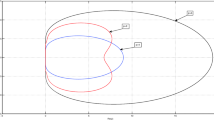Abstract
Almost Runge–Kutta methods were introduced to obtain many of the advantages of Runge–Kutta methods without their disadvantages. We consider the construction of fourth order methods of this type with a special choice of the free parameters to ensure that, at least for constant stepsize, order 5 behaviour is achieved. It is shown how this can be extended to variable stepsize.
Similar content being viewed by others
References
J.C. Butcher, An algebraic theory of integration methods, Math. Comp. 26 (1972) 79–106.
J.C. Butcher, An introduction to “Almost Runge–Kutta methods”, Appl. Numer. Math. 24 (1997) 331–342.
J.C. Butcher, ARK methods up to order five, Numer. Algorithms 17 (1998) 193–221.
J.C. Butcher and N. Moir, A general linear method of order 5, in preparation.
G.D. Byrne and R.J. Lambert, Pseudo Runge–Kutta methods involving two points, J. Assoc. Comput. Mach. 13 (1966) 114–123.
R. Caira, C. Costabile and F. Costabile, A class of pseudo Runge–Kutta methods, BIT 30 (1990) 642–649.
Z. Jackiewicz, R. Renaut and A. Feldstein, Two-step Runge–Kutta methods, SIAM J. Numer. Anal. 28 (1991) 1165–1182.
S. Tracogna and B. Welfert, Two-step Runge–Kutta methods. Theory and practice, BIT 40 (2000) 775–799.
Author information
Authors and Affiliations
Rights and permissions
About this article
Cite this article
Butcher, J.C., Moir, N. Experiments with a New Fifth Order Method. Numerical Algorithms 33, 137–151 (2003). https://doi.org/10.1023/A:1025503719518
Issue Date:
DOI: https://doi.org/10.1023/A:1025503719518




